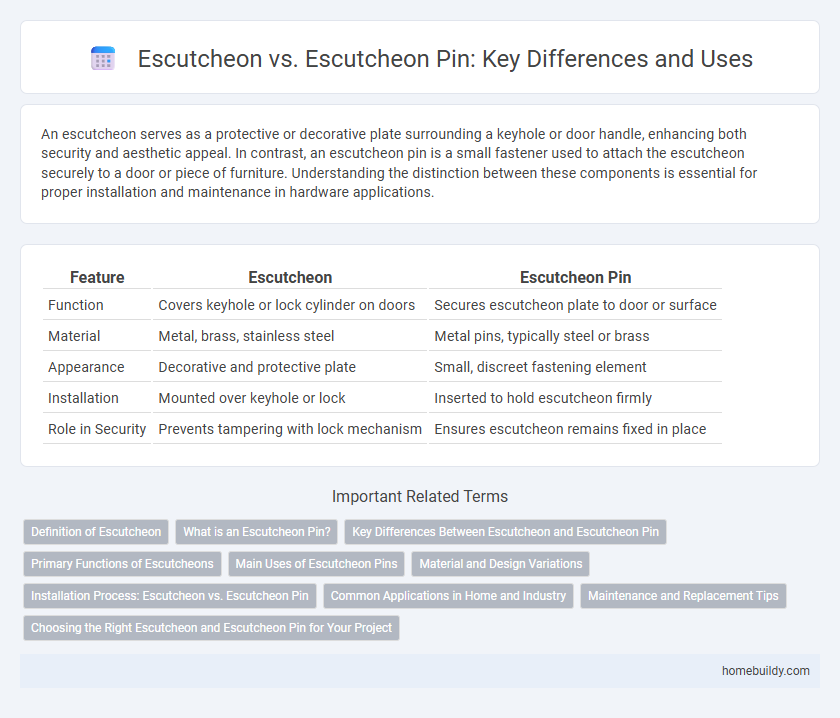An escutcheon serves as a protective or decorative plate surrounding a keyhole or door handle, enhancing both security and aesthetic appeal. In contrast, an escutcheon pin is a small fastener used to attach the escutcheon securely to a door or piece of furniture. Understanding the distinction between these components is essential for proper installation and maintenance in hardware applications.
Table of Comparison
| Feature | Escutcheon | Escutcheon Pin |
|---|---|---|
| Function | Covers keyhole or lock cylinder on doors | Secures escutcheon plate to door or surface |
| Material | Metal, brass, stainless steel | Metal pins, typically steel or brass |
| Appearance | Decorative and protective plate | Small, discreet fastening element |
| Installation | Mounted over keyhole or lock | Inserted to hold escutcheon firmly |
| Role in Security | Prevents tampering with lock mechanism | Ensures escutcheon remains fixed in place |
Definition of Escutcheon
An escutcheon is a protective or decorative plate that surrounds a keyhole, door handle, or faucet, enhancing the aesthetics and preventing damage to the surface. In contrast, an escutcheon pin is a small fastening device used to secure the escutcheon plate in place. Understanding the definition of escutcheon highlights its primary function as both a design element and a protective barrier for openings on doors, furniture, or plumbing fixtures.
What is an Escutcheon Pin?
An escutcheon pin is a small, specialized fastener used to secure an escutcheon plate to a surface, typically around keyholes or door handles. Unlike the escutcheon itself, which serves as a decorative or protective cover, the escutcheon pin ensures the plate stays firmly attached without visible screws. These pins are often made of metal and designed to be discreet, blending seamlessly with the escutcheon for a polished finish.
Key Differences Between Escutcheon and Escutcheon Pin
An escutcheon is a decorative or protective plate used around a keyhole or door handle, while an escutcheon pin specifically secures the escutcheon to the door or surface. The escutcheon serves both aesthetic and functional purposes, covering keyhole edges, whereas escutcheon pins are small fasteners designed for stability and alignment. Understanding these distinctions helps in selecting the right hardware component for door installation or restoration projects.
Primary Functions of Escutcheons
Escutcheons primarily serve as protective and decorative plates that cover keyholes or lock cylinders, enhancing security by preventing tampering and concealing mechanical components. Unlike escutcheon pins, which are small fasteners used to attach or secure the escutcheon to a door or furniture surface, escutcheons provide a finished, polished appearance while also safeguarding against wear and damage. Their main functions include improving durability, maintaining aesthetic appeal, and ensuring proper alignment for locking mechanisms.
Main Uses of Escutcheon Pins
Escutcheon pins primarily serve to secure escutcheons, which are decorative or protective plates covering keyholes or door hardware, ensuring a neat and stable attachment to doors or furniture. These pins are designed for durability and precision, providing a discreet fastening method that maintains the aesthetic appeal of the escutcheon plate. Unlike the escutcheon itself, which functions as a protective or decorative element, escutcheon pins are essential hardware components that enable proper installation and long-term stability.
Material and Design Variations
Escutcheons are typically crafted from materials like brass, stainless steel, or zinc alloy, offering a broad range of finishes such as polished, brushed, or antique to complement various aesthetic preferences. Escutcheon pins, usually smaller and made primarily from metal or plastic, serve as fasteners or decorative accents with simpler designs tailored for secure attachment rather than ornamental appeal. Material durability and design complexity distinguish escutcheons, which often feature intricate patterns or embossed details, from the more utilitarian, minimalistic escutcheon pins.
Installation Process: Escutcheon vs. Escutcheon Pin
The installation process of an escutcheon involves securing the decorative plate directly onto the surface around a keyhole or lock, often using screws or adhesive to ensure a flush, permanent fit. In contrast, an escutcheon pin requires insertion through the plate into the door material, anchoring it securely with a pin mechanism that is typically less visible and designed for quick removal or replacement. Choosing between an escutcheon and escutcheon pin depends on the desired balance between installation permanence, aesthetic finish, and ease of maintenance.
Common Applications in Home and Industry
Escutcheons are decorative or protective plates used to conceal and protect keyholes, locks, or pipe penetrations in walls, doors, and furniture, commonly found in both residential and commercial buildings. Escutcheon pins, smaller fasteners specifically designed to secure escutcheons in place, are frequently used in woodworking, cabinetry, and metalworking industries. While escutcheons provide aesthetic and functional value by covering openings, escutcheon pins ensure stability and precise attachment, making them essential components in home hardware installations and industrial assembly processes.
Maintenance and Replacement Tips
Escutcheon plates require regular cleaning with mild soap and water to maintain their finish and prevent corrosion, while escutcheon pins should be inspected for rust or bending to ensure secure attachment. For replacement, choose escutcheons and pins that match the original dimensions and material to maintain aesthetic consistency and hardware functionality. Avoid abrasive cleaners and ensure pins are properly seated to prevent loosening or damage during maintenance.
Choosing the Right Escutcheon and Escutcheon Pin for Your Project
Selecting the right escutcheon and escutcheon pin depends on the specific application and material compatibility to ensure a secure and aesthetic fit. Escutcheons typically serve as decorative or protective plates around keyholes or fittings, while escutcheon pins are used to fasten these plates firmly to surfaces. Prioritizing corrosion resistance, size, and finish matching the escutcheon will enhance durability and appearance in your project.
escutcheon vs escutcheon pin Infographic

 homebuildy.com
homebuildy.com